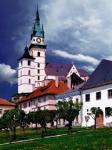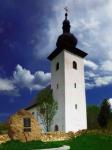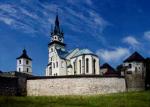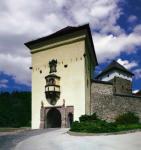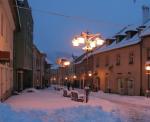Contact
CK Slovak Folk TravelŠtefánikovo nám.33/40, 967 01 Kremnica
mobil: +421 905 153 692
tel: +421 45 671 65 88
fax: +421 45 671 65 88
e-mail: info@slovakfolktravel.sk
Booking
Availability
Links
History
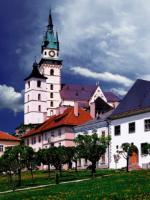
KREMNICA AND IT’S SURROUNDING
Kremnica belongs to the medieval towns, which, in times of their glory, were attended by monarchs, and other men of note, who had tried to capture the town and possess the rich deposits of gold.
It is assumed that gold and silver were minted in Kremnica from the tenth century. However, the real boom came up in the 14th century.
On November 17th 1328, the Hungarian King Charles Robert of Anjou granted the settlement of Cremnychbana with privileges of a free royal minting and mining town. At the same time he established the royal mint, which produced large amounts of golden and silver coins.
Kremnica's ducats - so called Florins belonged to the most valuable coins in Europe. Ever since it's founding in 1328 Kremnica's mint continues to operate which makes it a rarity within the European mints.
Gold and coins brought fame and glory to the town. Kremnica was the home of the chamber earl, who was the head of the mint chamber, which managed 12 mine galleries. He was responsible for mining enterprises and, as the monarch's deputy; he controlled the exploitation of precious metals and the quality of the coinage. Kremnica had a leading position in the union of seven middle-slovak mining townsdue to its gold production. In the 14th century in Hungary, Kremnica was also called "Golden Kremnica".
The town's historical centre together with the castle creates a very unique and individual example of gothic urban planning. Today's visitors are not coming to Kremnica because of the gold, but because of the town history, the well-preserved monuments, the beautiful scenery and the ability to enjoy sports and tourism throughout the year.
HISTORICAL MONUMENTS OF KREMNICA
Town castle - the Church of St . Katarina (patroness of the town) dominates the castle complex as well as the the town. Town castle was built gradually from the 13th up to 15th century. Town castle has been part of the cultural heritage since 1970. Part of the castle is also beautifull roman-catholic church from the 16th century „Church of St. Katarina“. Small (clock) tower is placed on the west side of castle complex in parkan wall of the castle walls. It was built also in 14th century and has four floors separated by stone string course. In the tower are baroque bells. Temporary name Clock tower was used because on the third floor was a clock placed.
The Town Hall (Štefánikovo nám. 1/1). First documented mention of the hall comes from 1441. The town repurchased the building and thanks to the reconstruction of this gothic burgher's house was rebuilt after 1738 as the Town Hall. In the middle of the rail is the figure of Justice.
The Mint(Stefánikovo nám. c. 25/24). Oldest part of today's Mint is located on the northern part of the square, it was built in the 15th century . The previous Mint was built in the northern part of the town had started in 1329 to mint first Hungarian coins called Grosh and in 1335 also Gold florins. Known as Kremnica's florins and they minted also minted silver groshes and denars.
A dominant - feature of the square is the baroque plague pillar of The Trinity. Primarily it was a place of a smaller stone pillar from 1711. It was disassembled in 1761 and in 1776 it was moved to a village called Horná Ves. The Trinity pillar has triangular section plan and its main side is oriented on west. The composition is dynamic, with large number of statues and statues of angels. It is an artistic piece of Dionyz Stanetti and M. Vogerle after their death was the pillar finished by Vogerle journeyman T. Mayer . The pillar has undergone several reconstructions last one was completed in 2006.
A baroque fountain from 18th century is placed on the northern side of the square - most probably it was also made by D. Stanetti. It has convex-concave curves in plan. There was originally a statue of Neptune in the middle. But there were not enough archival details about the statue expression exist so the middle of fountain was changed by modern sculptors. The work was undertaken between 1990-1992.
The red tower is a three floor circular bastion .The interior comes from the 1970s It has metal twisted staircase. The town fortification clearly borders the old town centre and is connected to the fortification of the town castle.
The barbican was built out into the lower gate in 1530. It is also square shape and on the ground floor it has two passing openings - a larger one with half-round portal and a rectangular countersunk for the draw bridge which was used by carriages. The smaller openinge has a saddle portal which was used by pedestrians.
Houses of miner's folk architecture of the 19th century and beginning of 20th century. They were ground, rustic or stone, plastered or storied -with a wooden courtyard gallery. A standard type of a miner's house has three rooms with a central corridor. In storied houses the steps placed in the corridor and they led upstairs to a courtyard gallery. Ceilings are wooden and timbered with a top shelter. Courtyards are made from wood and are supported by timbers which is a typical design of miner's houses in Kremnica and surrounding area . The roofs are a saddle shape and its shield is finished by half wagon headed ceiling or the whole roof is wagon headed. Covering were originally used wooden shingles.
 Print
Print Mapa stranky
Mapa stranky Admin
Admin





